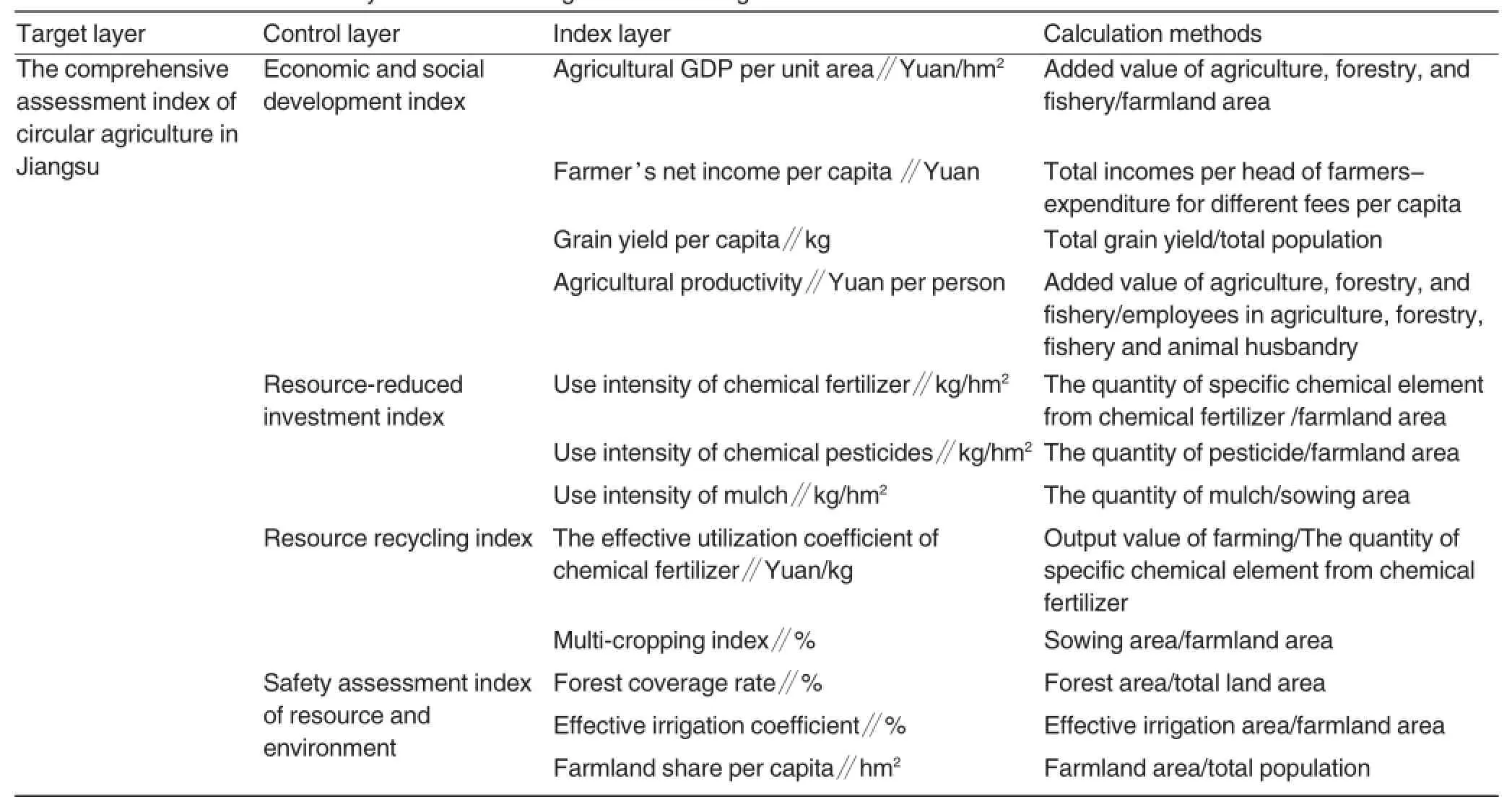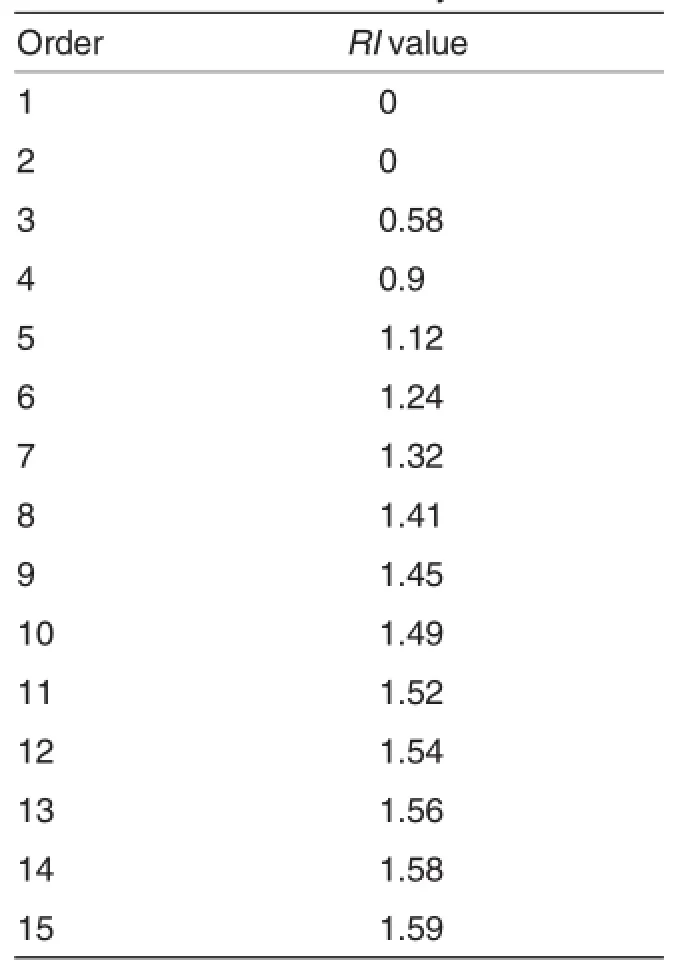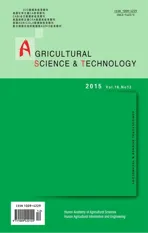Assessment and lmplementation lntention of Circular Agriculture in Jiangsu Province with a Case of 20 Farmers’Professional Cooperatives in Huai’an City
2015-11-08XiangLlManWUCaimingXU
Xiang Ll,Man WU,Caiming XU
Institute of Agricultural Economics and Information,Jiangsu Academy of Agricultural Sciences,Nanjing 210014,China
Assessment and lmplementation lntention of Circular Agriculture in Jiangsu Province with a Case of 20 Farmers’Professional Cooperatives in Huai’an City
Xiang Ll,Man WU,Caiming XU*
Institute of Agricultural Economics and Information,Jiangsu Academy of Agricultural Sciences,Nanjing 210014,China
Circular agriculture is of practical significance for Jiangsu agriculture.The research conducted quantitative analysis on circular agriculture in Jiangsu by establishing assessment index system of circular agriculture development.In 2013,most indices of Jiangsu circular agriculture kept higher than national levels,but many problems exist such as excessive uses of chemical fertilizer,pesticide and mulch. Therefore,it is effective for advancing circular agriculture in Jiangsu to stabilize government fiscal support and broaden financing channels.
Circular agriculture;Development;Assessment;Implementation
A ccording to China’s No.1 Central Document in 2015,it is necessary to accelerate shift of agricultural development pattern with focus on agricultural modernization,from extensive management relying on yield and resources consumption to sustainable intensive pattern with highlights on the number,quality and profit,improving competitiveness,and innovation on agricultural science and technology in order to walk the way of modernized agriculture featured by high-efficient,safe,resource-saving,and environment-friendliness.It is notable that priority should be given to conservation and environmental remediation of Beijing-Tianjin-Hebei metropolitan circle,Silk Road Economic Belt and the Yangtze River E-conomic Belt[1].Jiangsu Province,situated in the core of the Yangtze River Economic Belt,should make full use of self-advantages to accelerate shift of agricultural development pattern and to achieve agricultural modernization in China[2],advance greening,sustainable and low-carbon development, and convert deteriorated eco-environment from the source into the new featured by resource saving,environment conservation,led by basic national policies saving resources and protecting environment,as well as the policy of saving,protection and natural recovery.Ecological circular agriculture is just a pattern available for resolving the issue of low yielding of traditional agriculture,decreasing number and quality offarmlands,and heavy pressure on rural eco-environment.
The Necessity for Jiangsu Province to Advance Circular Agriculture
The effective method for Jiangsu to makebreakthroughon resource barrier
East China where Jiangsu is located is the region featured with the most sophisticated intensive agriculture.Since establishment of China,Jiangsu farmlands are decreasing with the rate over 10 000 hm2yearly.Con-sequently,farmland area is just 600.3 m2per capita in the province,and water resources at 432 m2,representing 1/5 of national level[3-4].Circular agriculture is the act of farming based on recycling and multilevel utilization technology in order to reduce production wastes and improve resource use rate,coinciding with Jiangsu agriculture orientation.
An important strategic choice for crop-producing areas in Jiangsu
Recently,the issue of straw processing is always a concern for central or local governments.Jiangsu is a big crop-growing province,and has 38 counties or districts producing over 500 million kg crops.Straw mulching is a representative processing method under the principle of saving energy and reducing discharges. What's more,straws are a part of renewable energy sources and the recycling is a choice for improving resource use and transforming agricultural growth pattern.
An effectivewayforadvancing Jiangsu agriculture
Circular agriculture is accelerating high-efficient use of agriculture resources to save energy and reduce discharge,in order to increase farmers’incomes and promote rural and modern agriculture sustainable development.Therefore,it enjoys social,economic and ecological benefits.For example,Feng County,Xuzhou City,has about 1.7×105hm2orchards,and the circular agriculture pattern has formulated featured by duck,biogas,fruit and enterprise.Specifically,flaw Chinese olive and fallen fruits can be used for producing fruit juice;pomace is used as fodders and duck manures are used for generation of marsh gas;biogas manure is used for application of the orchards[5].It is obvious that circular agriculture advances economy and increases farmer’s incomes.
A new carrier of broadened functions of Jiangsu agriculture
In modern society,agriculture is endowed with the functions of guaranteeing national food safety,improving eco-environment,cultural leisure,besidessupplying high-efficientcrops and high-quality food.Developing circular agriculture has become an inevitable choice for achieving sustainable agriculture in Jiangsu and can be a platform of leisure agriculture by scientific design of biological cycle pattern combining farming and animal husbandry and ecological cycle characterized by nutrient enrichment and re-use technology.
Assessment and Analysis on Circular Agriculture in Jiangsu
Construction of assessment index system
According to Circular Economy Assessment Index System compiled by National Development and Reform Commission,Ministry of Environmental Protection,and National Bureau of Statistics[6],Jiangsu agriculture development assessment has to take social,economic,and ecological benefits into consideration,as well as key technology index in order to precisely and comprehensively reflect input/output terminal and operation process of agriculturalsystem,as follows:
The first is economic and social development index,which mainly indicates output terminal effects of the system,namely economic and social benefits from sustainable agriculture in Jiangsu.
The second is resource-reduced investment index,incorporating status quo of regional agricultural input terminal,which reduces resource consumption from the source.
The third is resource recycling index,indicating resource recycling and use in agriculture production in Jiangsu,which corresponds to the demands of converting wastes into resources,saving resources and recycling use.
The final refers to safety assessment index of resource and environment,which suggests that Jiangsu agriculture has effects on agricultural environment and resource safety.
The research classified circular economydevelopmentassessment index system into target,controlling and index layers on basis of agriculture development of Jiangsu.In accordance with Delphi method,the research selected 12 assessment factors and established an assessment index system of Jiangsu circular agriculture with consideration of index sustainable availability(Table 1).
The determination of assessment index weight
Index weight refers to the importance of different indices with same objective.The research determined weights of different indices of Jiangsu circular agriculture by analytic hierarchy process and Delphi method.
Construction of comparison matrix The judgment matrix describes importance of different factors in every level relative to those in upper levels.In general,it is evitable that the advantage or disadvantage could be determined by comparisons for two factors.The research made assessment on development factors of sustainable agriculture in Jiangsu by consulting experts and scale method(Table 2).
Determination ofcomprehensive assessment index weight It is necessary to conduct comparisons on differentfactors atconstructing the judgmentmatrixand everymatrix concerns n(n-1)/2 comparisons.If the value of n is higher,it is difficult for transitivity to be guaranteed.What’s more,errors are inclined to occur by 1-9 scale method.In contrast,analytic hierarchy process used in the research is not so strict consistency of comparison matrix,butthe inconsistency should be not too high to be accepted. Therefore,it becomes crucial to conduct consistency detection on matrix.
Assuming CI=(λmax-n)/(n-1),λmaxis the maximal eigenvalue of judgement matrix A and n is the order of comparison matrix.The lower CI value,the higher consistency of comparison matrix.Vice versa.Meanwhile,random consistency index(RI)was introduced (Table 3)and RI calculation of order 2,3 and 4 were concerned in the research.
When n≥3,CI-to-RI rate is defined as consistency rate CR.As reciprocal matrices with order 1 and 2,it can be concluded that RI is 0,and CR is defined as 0.If CR<0.1,the matrix A can be accepted,or the inconsistency should be modified.
After normalization of maximum eigenvalue vector,the vector(W)can be concluded reflecting influence weight on corresponding factors in upper layer.Then,W is called weight vector.Finally,the weight of the target-ed layer can be computed by step-bystep result of multiplying weight coefficients in different layers.

Table 1 The assessment index system of circular agriculture in Jiangsu

Table 2 Determination of values of scales of judgment matrix aij

Table 3 Random consistency index
The weight of assessment index of Jiangsu circular agriculture economy developmentcan beconcluded(Table 4).
Data input and analysis
As shown in Table 4,as for indices in layer B,the resource-reduced investment index and resource recycling index dominated in terms of influence,with total weights of 78%,and safety assessment index of resource and environment,followed by economic and social development index at 13.86%and 8.03%,respectively.Besides,12 indices were chosen from layer C,of which 4 items had significanteffects on layerB,including farmer’s net income per capita(53.44% ), mulch use intensity(72.58% ),multiplecroppingindex(75% )and forestcoverage rate(59.36%).
The data of circular agriculture assessment index were shown in Table 5 from Jiangsu Statistical Yearbook during 2010-2014.
The research selected averages of national indices as assessment standard from China Statistical Yearbook and performed quantitative comparisons between Jiangsu and national averages in order to make further assessment on circular agriculture in Jiangsu.The results showed that most indices kept higher than national level,especially for agricultural GDP per area,which reflects the position held by Jiangsu as a strong economic province.Nevertheless,there is a widespread concern over the issue of the excessive use of chemical fertilizer and pesticide,as well as per capita share of farmland.
It can be concluded that data normalization is necessary due to different index properties of circular agriculture and the processed data were shown in Table 5 by method of specific gravity.In addition,the assessment coefficients can be computed of different indices (Table 6).Specifically,the coefficients can be classified into positive and negative ones.For the former,the higher the value,the better the circular agriculture and the lower the latter,the better the agriculture,as follows:
Positive index:Xij’=Xij/Xiand negative index:Xij’=Xi/Xij,where Xij’is the normalized value;Xiis a standard value;Xijis the original value.
Every index in the assessmentsystem infects circular agriculture development from different aspects. Therefore,circular agriculture development assessment is a comprehensive one and the research performed weighting function,as follows:

Table 4 The assessment index and weight of circular agriculture development in Jiangsu

Table 6 The assessment coefficients of circular agriculture in Jiangsu

Table 7 The establishment time of investigated cooperatives
As shown in Fig.1,circular agriculture was growing in Jiangsu,and went up by 5%in 2013 compared with 2009.
As shown in Fig.2,economic and socialdevelopment,resource recycling index and safety assessment index of resource and environment be-longed to positive indices and the indices advanced Jiangsu circular agriculture within 5 years.Resource-reduced investment index was negative and the higher the index,the more backward Jiangsu circular agriculture.
It can be concluded that economic and social development index grew the fastest.For example,it went up by 63.48%within 5 years.Therefore,the development accelerates circular agriculture in Jiangsu.
As for resource-reduced investment index,chemical fertilizer and mulch are excessively applied,preventing the practice of reducing agricultural resources and circular agriculture development.For recent 5 years,the index kept decreasing,indicating thatthe influence is declining on Jiangsu circular agriculture,which has been closely linked to transformation of economic development mode,such as implementation of provincial ecological projects.
In addition,resource recycling index and safety assessment index of resource and environment both affect Jiangsu circular agriculture,with total weight of 50%.In recent 5 years,the growth rates of the two indices were much closer at 15.87%and 16.7%,respectively.Per capita share of farmland is significantly lower than national level,which drives the contribution of safety assessment index of resource and environmentdown in circular agriculture.Hence,effective use of a gricultural resources,improvement on environment-protection consciousness and the policy of returning farmlands to forests would all make contribution to circularagriculture developmentin Jiangsu Province.
lmplementation Willingness and Effect Analysis on Circular Agriculture in AgriculturalArea in the North of Jiangsu
The research conducted questionnaire survey on implementation willingness of circular agriculture in Jiangsu and performed statistical analysis on the results in order to advance circular agriculture.
Design of questionnaire survey and research
Recently,Jiangsu cooperative organizations advance rapidly,supported by farmers’favorable policy.For instance,Jiangsu cooperative organizations took the first place in terms of proportion of farm households in the cooperatives,the number of registered member,the number of average member in cooperatives and the contribution of capital.It is obvious that cooperatives are increasingly becoming a key power of Jiangsu modern agriculture.
With a case of Huai’an City,the research performed investigation on implementation willingness for agricultural cooperatives and effects of circular agriculture technology by selecting 20 cooperatives and conducting questionnaire as per random sampling.The investigation covers basic information of farmer’s cooperatives,production,willingness and achievements of circular agriculture technology.
Statistical analysis and major conclusion
Basic characters of cooperatives As shown in Table 7,the investigation contained cooperatives established in different years and most were constructed 1-5 years ago,dominated by the cooperatives containing over 50 households and supplemented by the ones containing 20-50 households. On the other hand,most investigated members are educated at high school level or below.
The investigated members are distributed in different industries such as farming,breeding,and agricultural product processing(Fig.3),and annual incomes are generally within 10 million yuan.
Recognition on circular agriculture Among the investigated members,only one showed they are not so familiar with circular agriculture;45%members have a good grip of circular agriculture in operation and effects;about 50%members know a little(Fig.4).It is clear that the concept of circular agriculture is not so strange to farmers in Jiangsu.
As shown in Fig.5,as for the channels for cooperative members to get information on circular agriculture,85%members chose TV,newspaper,and internet,followed by information feedback from market(45%),agricul-tural techniques popularization system by government(40%),science and technology training (40%)and relatives(10%).
lmplementation and willingness of circular agriculture From statistics,circular agriculture mode was applied in only 30%cooperatives in production and management.It is notable that the motivations for applying circular agriculture is to consume agricultural wastes and reduce agricultural nonpoint source pollution,followed by applying for fiscal subsidies,improving agriculturalproducts and branding(Fig.6).It can be concluded that most agricultural producers applying circular agriculture are aware of environment protection.In addition to that,government promotion and improving brand effect play a key role in implementing circular agriculture technology.
It is clear that 6 agricultural cooperatives depended on self-supported capitals;4 cooperatives got special capitals from local government;one obtained the capital from bank loan. Besides,6 cooperatives showed that governments ortrade associations would give supports in terms of capital,technology,land and tax preference.
On the other hand,circular agriculture projects were dominated by circular aquaculture,followed by multilevel use of agricultural waste,and agriculture and animal husbandry integration.
It is surveyed that the application of circular agriculture increases farmer’s incomes and has positive effectsonenvironmentimprovement(Fig.7).
Among 20 surveyed cooperatives,circular agriculture was not applied by farmers in 14 cooperatives,taking up to 70%.It is high investment that prevents popularization of circular agriculture(Fig.8).
Conclusion
To develop circular agriculture is an important way for the strategy of agricultural sustainable development,which coincides with intensive,highefficient and environment-friendly orientation of Jiangsu agriculture.Recently,Jiangsu circular agriculture is increasingly accelerating.For example,most indices in the circular agriculture in Jiangsu keep higher than national levels based on analysis of data in 2013.However,the excessive uses of chemical fertilizer,pesticide and mulch have considerably prevented circular agriculture in Jiangsu and it is of significance to improve the consciousness of environment protection,such as farmland protection.
The research has demonstrated that the motivation of applying circular agriculture in Jiangsu is to consume agricultural wastes,win subsidy from government and establish high-quality agricultural brands,because circular agriculture would not only improve production and living environment,but also enhance agriculturaloutputs,broaden marketing channel and reduce investments of means of production.Currently,high investment costs have significantly prevented application of circular agriculture and the application proportion should be further improved in Jiangsu.
From researches at home and abroad,it is known that circular agriculture is mainly driven by science and technology,guaranteed by policy,and key supported by investments.In future,therefore,besides improving laws,rules and relevant systems,and reinforcing S&T innovation,it is necessary to guarantee capital investments,reinforce financial supports on ecological and circular agriculture mode,by striving for national funds and broadening financing channels to advance application circularagriculture and speed up modernization of Jiangsu agriculture.
[1]Opinions on reinforcing reform and innovation and accelerating constructionof agricultural modernization,China’s No.1 Central Document in 2015(2015年中央一号文件:《关于加大改革创新力度加快农业现代化建设的若干意见》).
[2]Opinions on implementing agricultural modernization project(关于实施农业现代化工程的意见)[EB].Xinhua Daily(新华日报),2011,6,14.http://xh.xhby.net/ mp2/html/2011-08/04/content_405663. htm.
[3]ZHENG JC(郑建初),CJEN LG(陈留根),ZHEN RH(甄若宏),et al.Study on modern circularagriculture development in Jiangsu Province(江苏省现代循环农业发展研究)[J].Jiang Journal of Agricultural Sciences(江苏农业科学),2010(1):5-8.
[4]LI X(李响),ZHOU Y(周鹰),LI LH(李丽华),et al.The Development gap between Jiangsu and developed countries in modernization(江苏与发达国家农业现代化水平的差距)[J].Journal of Agricultural Sciences(江苏农业科学),2012(12):385-387.
[5]XU Q (徐琪).The practice and innovation of Jiangsu circular agriculture(江苏循环农业发展的实践与创新)[J].Science and Technology and Economy(科技与经济),2008(5):45-47.
[6]Illustration on circular economy index system and assessment index system of circular economy by National Development and Reform Commission,Ministry of Environmental Protection,National Bureau of Statistics(中国发展改革委会同国家环保总局,中国统计局:《循环经济评价指标体系》和关于《循环经济评价指标体系》的说明)[EB]. 2007,6,27.http://hzs.ndrc.gov.cn/newfzxhjj/zcfg/200708/t20070814_235955. html.
Responsible editor:Xiaoxue WANG
Responsible proofreader:Xiaoyan WU
江苏省循环农业发展水平评价及实施意愿研究——以淮安市20家农民专业合作社为例
李响,吴曼,许才明*(江苏省农业科学院农业经济与信息研究所,江苏南京210014)
循环模式的实施对江苏现代农业发展具有重要的现实意义。通过构建江苏省循环农业发展评价指标体系,对江苏循环农业经济发展水平进行定量分析,结果表明,近五年来江苏循环农业经济发展水平不断提升,且提升速度逐年加快。到2013年,江苏循环农业发展评价指标中的大部分明显高于全国平均水平。但化肥、化学农药、农膜过度施用的问题亟待解决。稳定政府资金保障,拓展资金筹集渠道是江苏继续加快推进循环农业模式的最有效手段。
循环农业;发展水平;评价;实施意愿
江苏省农业科技自主创新基金[编号:CX(13)5068]。
李响(1982-),女,吉林吉林人,博士,副研究员,主要研究方向农业经济,E-mail:njaulx@sina.com。*通讯作者,研究员,主要研究方向为农业产业经济,农业规划咨询,E-mail:caimingxu@sina.com。
2015-10-03
Supported by Jiangsu Agricultural S&T Self-innovation Project(CX(13)5068).
*Corresponding author.E-mail:caimingxu@sina.com
Received:October 3,2015 Accepted:November 16,2015
修回日期 2015-11-16
猜你喜欢
杂志排行
Agricultural Science & Technology的其它文章
- An lnnovative Strategy for Reciprocal Distant Hybridization between Spartina alterniflora and Rice
- Study on Absorptive Capacity to Formaldehyde and Physiological and Biochemical Changes of Scindapsus aureus Based on the Regulation of LaCl3
- Dynamic Variation in Sugar,Acid,and ASA Contents of‘Ganmi 6’Kiwifruit(Actinidia eriantha Benth)Fruits
- Construction and Development of GMS Agricultural lnformation Network Based on Stakeholder Analysis
- Effects of Different Decolorants on Retention Rate of Total Triterpenes in Fruit and Rattan Stems of Schisandra chinensis(Turcz.)Baill
- Determination of Heavy Metals inDendrobium candidiumWall.ex Lindl.by lCP-MS
